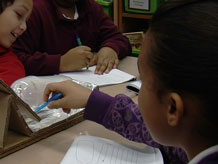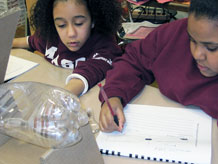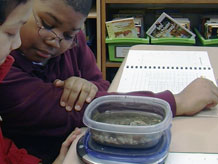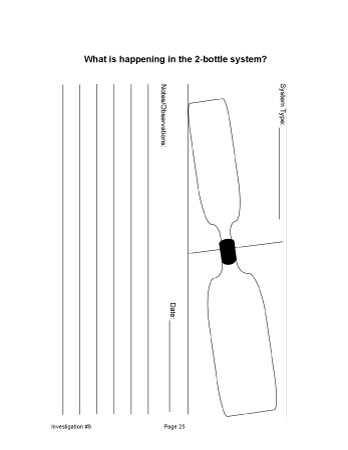What is happening in the 2-bottle system?
Plan Investigation 8

Investigation 7 highlighted the difference between an open and a closed system.
What does a 2-bottle system have in common with the Solar System? While this question may at first seem like a silly riddle, it calls attention on the concept of a system. Both the solar system and the 2-bottle system have physical boundaries, and both have components that interact within those boundaries.
The components within the three 2-bottle systems increase their interaction shortly after the lights are turned on. Students will notice changes at the start of this investigation. After sharing their initial understanding of a system, they focus on the components of the closed 2-bottle system and the now open mini-lake system. They end the class by carefully observing their "home" 2-bottle system and making drawings that record the initial changes. This is the first in a series of observations that document changes in the 2-bottle systems.
By the end of this investigation, students will understand that systems have components that interact within boundaries. They'll be able to describe the components of the 2-bottle systems and their mini-lake, and start to understand the transformations of the components within the systems.
Learning Goals
- Understand that a system has components that interact within the system boundary
- Start to understand the interaction of the components within the 2-bottle systems
| Sequence of experiences | ||
|---|---|---|
| 1. Ask the question | All Class | 10 Mins |
| 2. Observe the 2-bottle systems | Small Groups | 10 Mins |
| 3. Make meaning | All Class | 15 Mins |
| 4. Weigh the mini-lakes* | Pairs | 10 Mins |
* If possible, have students weigh the mini-lakes before school starts, or during a lunch period, to have additional time during this investigation.
Materials and Preparation
For the class:
- Post the investigation question in a place where all students can see it.
- 3 2-bottle systems
For each group:
- 1 digital scale
- 2 mini-lakes
Notebook Pages
1. Ask the question

Remind students that the purpose of studying the 2-bottle systems is to gather data about what happens to water after it disappears. Today they will carefully study changes in their "home" system and record their observations using annotated drawings.
Today's investigation question is:
What is happening in the 2-bottle systems?
What is a system?
Note: A system is a set of components that interact. Some systems are extremely complex while others are quite simple.
Introduce the term system.
- school system
- respiratory system
- transportation system
- solar system
Highlight these three essential ideas:
- Systems have components.
For a school system, some components include: students, teachers, classrooms, a curriculum, administrators, etc.
For the 2-bottle systems, the components are: water; blue food coloring, or salt, or earth materials, depending on the system; the air inside the bottles; and the inside surface of the plastic bottles. Heat from the lamp is energy that comes from outside of the system and has an influence on the interactions of the components.
- Systems have boundaries (edges or limits).
Determining the boundary means choosing what's inside and what's outside the system.
For the 2-bottle systems, the boundary is the plastic material that makes up the bottles. The lamp is outside the system, but the energy from the lamp is an input to the 2-bottle system.
- The components of a system interact within the boundaries.
In a school system, the teachers, students, the curriculum, administrators, etc. all interact.
The interactions of the components of the 2-bottle system (such as water, air, and earth materials) are the focus of our next set of investigations.
The 2-bottle system is a closed system. Elements inside the system will remain there, and nothing new will be added to the system. The mini-lakes with the covers off are open systems.
2. Observe the 2-bottle systems
Note: If the 2-bottle systems need to be moved an adult should transport them. Mishaps while moving the systems can result in water or other materials accidentally shifting from one bottle to another, upsetting the data.
If the lamps need to be turned off, the lower bottle will cool and condensation will start to form there.

Remind students of today's investigation question:
What is happening in the 2-bottle systems?
Students will start to answer the question by observing their "home" system and recording their observations using a new line drawing on a page titled [What is happening in the 2-bottle system?] in their Science Notebooks.
3. Make meaning
The 2–bottle systems — all three of them — look different today than they did when the class first set them up. Students have evidence of this because they made drawings of the systems on the first day, and have observations from today.
Purpose of the discussion
The purpose of this discussion is for students to jointly construct explanations for the changes they observed in the two-bottle system, explanations that are consistent with their observations and evidence.
Engage students in the focus question
What changes in the 2-bottle system have we observed and how do we explain these changes?
Students should refer to data in their Science Notebooks as they make claims, and provide evidence or reasoning. Possible responses include:
- Water is appearing as drops on the inside surfaces of the lower and upper bottles.
- The drops are not evenly distributed. For example, there are no drops on the surface closest to the lamp.
Note:
- Don't spend too much time discussing additional details (size of drops, etc).
- If students use the terms "evaporation" or "condensation", ask them to explain these processes in their own words.
- Wait until the Recap to introduce the term "condensation"; keep the focus on the process as opposed to the vocabulary.
Possible supporting questions
Where do you think the drops in the upper bottle came from? What makes you think that?
- The only water in the system is in the lower bottle; water can't get into the bottles from the outside. (Reasoning)
Did anyone actually see water move from the puddle in the lower bottle to the drops in both bottles?
- No.
How do you think the water got from the puddle in the lower bottle to the drops in other places?
- Tiny bits of water too small to see moved from the puddle into the air, the air had no place to go other than inside the bottles, and the water particles in the air (water vapor) formed water drops that collected on the inside surfaces of the bottles. (Reasoning)
What's the difference between parts of the bottle where there are no droplets and parts where there are lots of droplets?
- There are no droplets on the warmest part of the lower bottle.
Summarize the discussion and recap the investigation
Using the same language students have used, summarize their main ideas. Include the following key ideas:
- The change that has occurred in the two-bottle systems is that water drops have appeared on previously dry surfaces inside the bottles.
- Some claim that the drops of water come from the puddles in the lower bottles. They reason that the 2-bottle systems are closed and so there is no other source of water.
- No one saw the drops move from the puddles to the sides of the bottles. Some suggest that the water particles that moved were too small to see and were part of the air in the bottles.
Other observations include:
- The water drops are not evenly distributed; some places remain dry.
- The sand, salt, and blue dye have not appeared anywhere else.
Introduce the term "condensation" and explain condensation is the reverse of evaporation: condensation involves the formation of water drops while evaporation involves the disappearance of water drops.
As you recap the investigation, be sure there is understanding of these points:
- A system is a set of components that interact within a boundary.
- The components of the 2-bottle systems include water, air, plastic bottles, and the salt, dye, or Earth materials.
- The 2-bottle systems are closed systems because matter cannot get into or out of those systems.
- The change that occurred in all three of the 2-bottle systems is that drops of water have appeared on surfaces that were originally dry.
- We reason that the drops came from puddles in the lower bottles, because the 2-bottle systems are closed systems and there was no other source of water.
The class will continue to observe and develop explanations for changes in the system.
Note: At this point, students are not likely to have a complete explanation for the changes that they can observe in their closed system. Complete understanding of processes that cannot be observed such as evaporation and condensation requires multiple experiences with the phenomena and opportunities for discussion and reflection. What's important is that they begin putting the pieces of the explanation into place. They will have additional time in Investigation 9 to observe the bottles and continue to formulate explanations for what is happening.
By the time students develop a full explanation, it will include three important ideas:
- Water particles too small to see move out of the puddle in the lower bottle and become part of the air (evaporation).
- Because the 2-bottle system is a closed system, water in the air is trapped within the system.
- Water particles collect together on the cooler parts of the inside surface of the bottles to become visible again (temperature plays a role in the transformation called condensation).
4. Weigh the mini-lakes

Have students:
- Collect and weigh their mini-lakes. (Remind them to include the lid.)
- Record the weight in the table and on the graph in their Science Notebooks.
- Record other significant observations.
Students should continue to weigh their mini-lakes daily if possible and record the data. When all of the water has evaporated, they can stop.
- We know how much water we put in the mini-lake so when the mini-lake loses that amount of weight, we'll know the water is gone.
- We see if there's any water left and see if the material on the lake bottom feels dry.
Point out that, as they did when they dissolved salt, students are using weight to determine if and how much matter is present.





